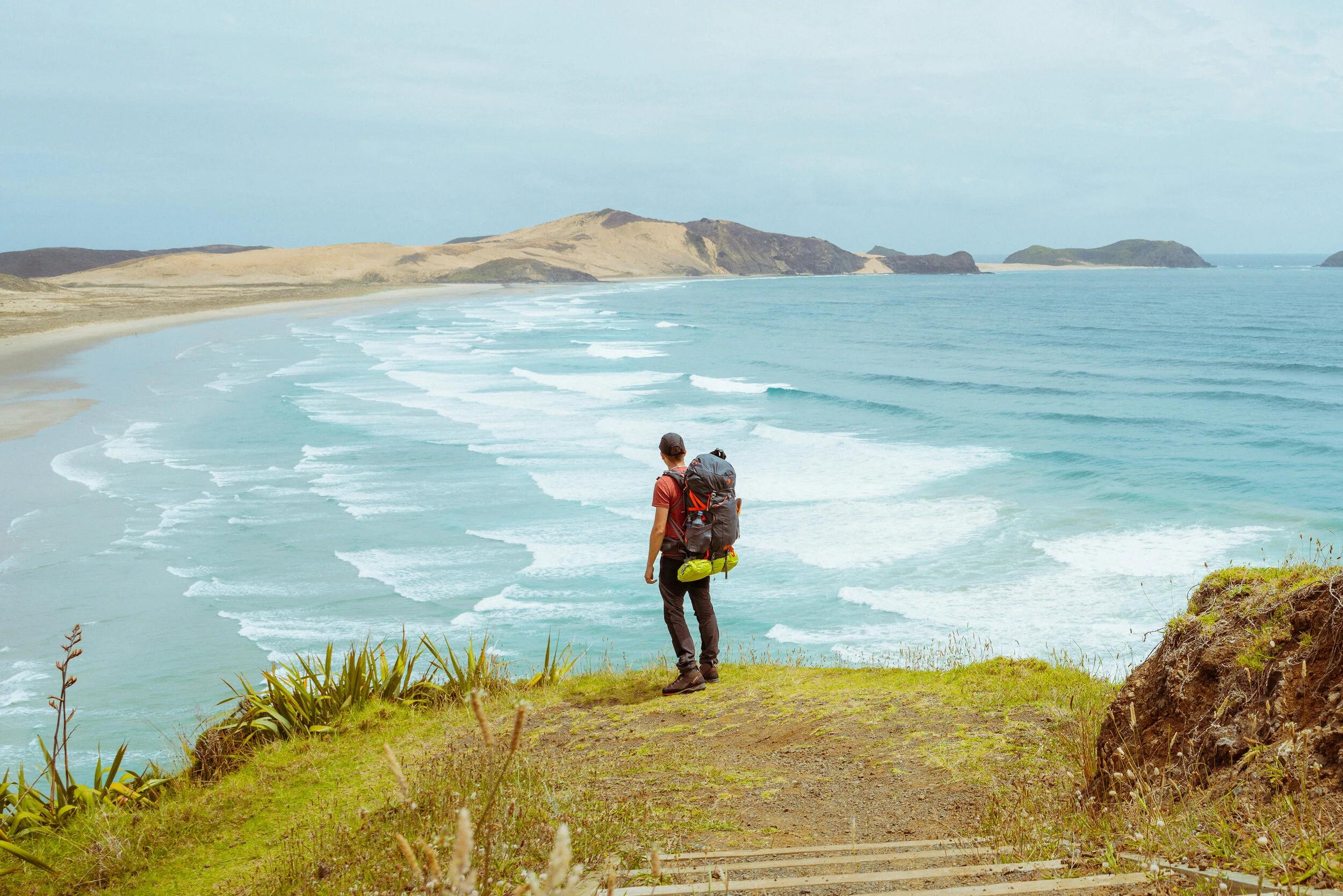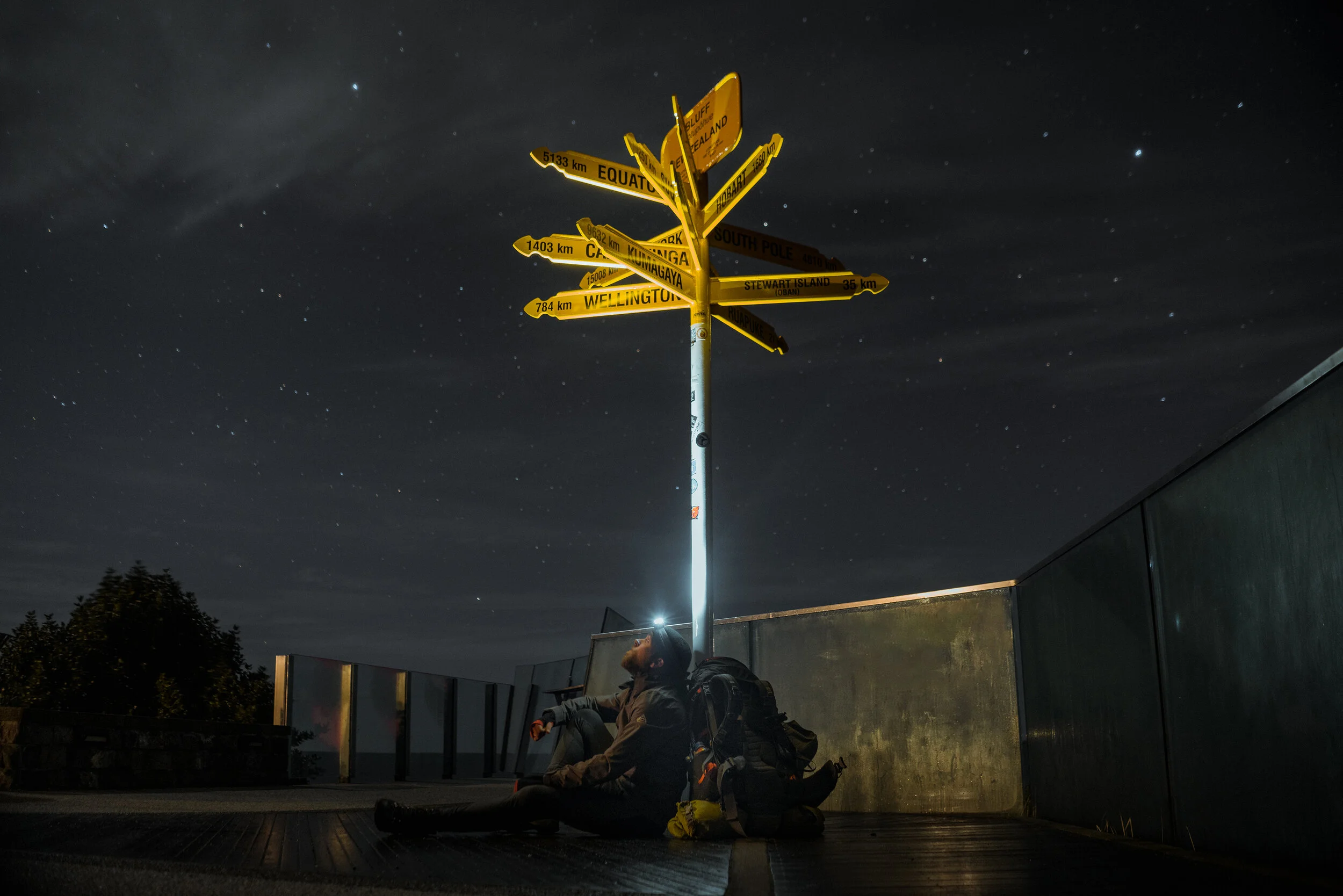2000 km by feet across New Zealand following Te Araroa Trail
I remember perfectly, it was the 4th of October 2018. After a long journey I land in New Zealand tired but happy to see my dream becoming true. However, the reality catches up with me quickly when only a few hours later I realized that my passport had disappeared. At that moment I knew that my trip was not going to happen as I planned.
Fortunately and by chance, the police at the airport has found my passport a few days later. In the meantime, my journey took a completely different turn after my best friend Thomas has sent me a mysterious blog article about a 3000 km hiking trail across New Zealand: Te Araroa Trail.
While doing some research, I realized that no documentary about this hike has been made before. I decided to follow my instinct and prepared myself for this adventure with the goal of making my first adventure film documentary.
CAPE REINGA, THE STARTING POINT
On December 21, 2018, I say goodbye to Tania, a Maori woman who kindly drove me to Cape Reinga the northernmost point of the North Island. I can hear her car driving off in the distance as I head towards the starting point of the trek. From there, I can see the Tasman Sea and the Pacific Ocean that meet creating a natural boundary with their distinctive blue color. After a brief stop at the Cape Reinga lighthouse, I tightened my backpack straps, clipped my camera to my strap and headed south towards Te-Werahi Beach, taking the first steps of a great adventure through New Zealand. I feel free!
I finish the first 12 kilometers by arriving at the first camp "Twilight Beach Campsite". Once my tent is set up, I eat my noodles and enjoy the sunset from my tent before spending my first night on the trek and letting myself be lulled by the sounds of the and let myself be lulled by the sound of the waves.
I didn't wait long to face the first big challenge.
THE FIRST STEPS ON TE ARAROA TRAIL
The next day at noon, as I started the first kilometers on the "Ninety Mile Beach", a 88 kilometers long beach, the rain started to fall and would not stop for 5 days. On this monotonous track, I see cars driving on the beach and I start saying to myself: "What am I doing here? How could I go from doing a roadtrip to walking the whole country?" I even consider hitchhiking but I had resisted the temptation. Each step is harder and harder and it become very mentally challenging: I laugh, I cry and I scream against the wind and the incessant rain.
2 days later I am still under the rain and I arrive at the third camp "Utea Park" a campsite located in the middle of nowhere between the big sand dunes where I meet Holger, a German walker that I had seen a few days earlier. We will decide to rent a room for two in order to dry our gears and to spend Christmas under a roof while waiting for the storm to pass.
This first section behind me, here I am inside the lands near the forest of Raetea which looks like a jungle. It is 9 am when we enter the "green hell" (it is the name that I gave it) with Holger and Luke, a New Zealand walker met several days before. We evolve very slowly because of the omnipresent mud, the lianas which cling to our bags and to navigational errors. If the ascent is hard, the descent is even more.. I slide due to the mud every 10min and I could almost laugh about it because it's so ridiculous but the only thing I am thinking of is to get out of this jungle.
11 hours and 16 km later, here I am finally out of the "green hell" with mud up to my waist and as a sign, in front of me a field of yellow flowers with a nice sunset and the song of the birds come to embellish this end of day.
THE FIRST INJURY
Towards the end of the Ninety Mile Beach I had sprained both my ankles; the pain at first was minor but I think that the repeated slips in the forest did not help and the pain is more and more present. A few days later after a painful day of walking I arrive at the Puketi Forest Campsite and I see my ankles have doubled in size. I took the decision to take 5 days of rest hoping to recover as soon as possible.
These first weeks were as much mental as physical I was not prepared to walk an average of 25 km a day and my body made me feel it. However, I am now physically and mentally ready for the rest of the adventure.
THE SOUTH ISLAND
I have just arrived in Picton in the South Island by taking the ferry through the Cook Strait to join Emeric, a french hiker and photographer with whom I was in contact since my arrival in New Zealand.
A few days earlier, I had to make a strong decision: to put aside the second half of the northern island to be able to walk the southern island as I had underestimated my budget. It is recommended to have 4500€ to 7000€ of budget. Unfortunately I only had 3000€ budget to walk the trail. I was thinking that it would be enough but I was wrong.
I walk in the South Island since several days now and the scenery has totally changed and the trail takes another dimension. We evolve in full nature with some sections long of 8 days in total autonomy like the one in the green and rocky mountains of the "Richmond Ranges" or in the Nelson Lakes National Park with its numerous blue lakes that can be admired from below or from the ridges.
As a storm approaches, I see Courtney a New Zealander who had both passed us. While chatting, she explains to me that she is realizing her dream of walking a “Thru Hike” and how much she loves her country and also the people who live there; warm and always ready to help others. She confides to me that at no time during the adventure she did feel in danger and that she feels proud to be able to accomplish such an adventure alone.
I continue my walk alone towards the south before I cross the path of Yusuke alias Ken a Japanese walker with whom I sympathize and speak in a more than approximate English but sometimes the language goes beyond the words - a look, a smile, a gesture is enough to be understood. He shares with me his vision of ultra light hiking and we surprise ourselves to walk at the same rhythm and it is quite naturally that we start meeting at the end of each day at the next campsite.
This evening at "Highland Creek Hut", I meet Peter a New Zealand walker of about fifty years old who walks section by section: being a policeman it is difficult for him to find 4-5 months of free time so for the last few years he has been walking an average of 3 weeks per year on Te Araroa in order to finish the trail. He confides to me that next year will be the last year and it will have taken him a total of 5 years to complete Te Araroa Trail.
THE LAST KILOMETERS ON TE ARAROA TRAIL
We continue to walk but the meetings become more and more rare on the trail and we are not far from being the last walkers of the season. We are at the beginning of April, the tree leaves are slowly turning orange and the majority of the walkers have already finished their adventure. Indeed, the recommended window to walk Te Araroa is a few months: from the end of September to early April.
As a sign that the end is near, I cross the dense, green and muddy forest of Longwood Forest which strangely reminds me of the beginning of the adventure. Then a few days later I'm back to walking on a long and monotonous beach to reach Invercargill. It feels like I am completing the circle.
It is 10 pm, the evening in the pub is full swing; we finish our beer, put on our bag one last time and decide to walk the last 32 km which separate us from Bluff, point of arrival of the trail. Little by little the music of the pub disappears and leaves place to the calm of the night.
The long walk on the road is hard on the feet but at the end of a turn I see in the darkness "Stirling Point" and this famous yellow sign, the same as the one in Cape Reinga. It is 4:30 am the village is deserted, I sit down for a few minutes to contemplate the stars while waiting for Ken to join me and let me lull by the noise of the waves. We both end up falling asleep on our mattresses until the sunrise and the first come of the tourists.
TIPS
When to walk Te Araroa Trail? It is best to start at the end of September and finish before the beginning/mid April.
How to organize it? All useful information is centralized on the official website of Te Araroa Trail : https://www.teararoa.org.nz
How long does it take? It takes an average of 120 days to walk the entire of Te Araroa Trail. You are free to walk at your own pace it is not a race.
What is the budget? Plan a budget between 4500€ and 7000€ for the 4-5 months. We would not think that walking in nature represents such a cost. There is the food, the accommodation (hut pass, camping, youth hostel, etc), the ferry to go from one island to another, shuttle-taxi to get supplies in villages, replacement of your gears if needed, and all the extras on the side.
What is the total length? The trek is 3000 kilometers long: The northern island is the is the longest with its 1600 km, the southern island is 1400 km long.
How to ressuply? Mostly when you walk through a village/city.However, in the South Island I sent some food parcels to different places from Wellington because there are very few options to get food in some of the villages you are walking through.
What gears to bring? I invite you to check my Te Araroa Gear List
WATCH “UP AND DOWN”
Synopsis: In 2019, during his journey to New Zealand, Dylan a photographer and filmmaker passionate by the outdoors decided to start an adventure of 3000 km by feet following #TeAraroaTrail : New Zealand’s Longest Hiking Trail. One goal in mind, to make his first adventure film documentary. Beyond the beauty of New Zealands landscapes, his journey led him to meet inspiring people from different backgrounds who shared their personal experiences and learnings. An invitation to adventure and to connect with people.




















